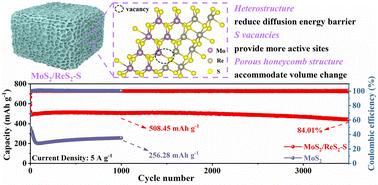一种具有S空位的新型无碳三维多孔蜂窝状MoS2/ReS2异质结构作为钠离子电池阳极
IF 9.2
1区 化学
Q1 CHEMISTRY, MULTIDISCIPLINARY
引用次数: 0
摘要
二硫化钼(MoS2)具有较高的理论容量和独特的片层结构,是一种很有前途的钠离子电池负极材料。然而,它的实际应用受到循环稳定性和速率能力较差的阻碍,这主要是由于极化子诱导效应导致的低电导率和缓慢的电荷转移。虽然碳基复合材料通常用于增强导电性,但它们通常存在容量贡献有限、接头密度低和界面稳定性不足的问题。在此,我们设计了一种新型的无碳三维(3D)多孔蜂窝状MoS2/ReS2异质结构(MoS2/ReS2-S),具有S空位,通过简单的NaCl模板策略制备。独特的三维多孔蜂窝状纳米结构减轻了循环过程中的体积变化,提高了活性位点的可及性。MoS2/ReS2异质结处的内置电场降低了离子扩散能垒,加速了钠离子迁移。此外,丰富的S空位提供了更多的活性位点,改善了反应动力学。系统表征和理论计算进一步表明,非均相结构和S空位的协同效应可以增强材料的电导率,促进电荷转移。正如预期的那样,MoS2/ReS2-S阳极具有很高的比容量(在0.5 a g−1下循环200次后为760.19 mAh g−1),卓越的倍率性能(在10 a g−1下为428.26 mAh g−1),以及出色的循环稳定性(在5 a g−1下循环3500次后仍保持441.8 mAh g−1)。这种无碳设计不仅解决了传统碳基阳极的局限性,而且为钠离子电池负极材料的开发提供了新的途径。本文章由计算机程序翻译,如有差异,请以英文原文为准。

A novel carbon-free 3D porous honeycomb-like MoS2/ReS2 heterostructure with S vacancies as anodes for sodium-ion batteries
Molybdenum disulfide (MoS2) is regarded as a promising anode for sodium-ion batteries with high theoretical capacity and unique lamellar structure. However, its practical application is hindered by inferior cycling stability and rate capability, primarily caused by low electrical conductivity and slow charge transfer resulting from polaron-induced effects. While carbon-based composites are commonly used to enhance conductivity, they often suffer from limited capacity contribution, low tap density, and insufficient interfacial stability. Herein, we designed a novel carbon-free three-dimensional (3D) porous honeycomb-like MoS2/ReS2 heterostructure with S vacancies (MoS2/ReS2-S), fabricated through a facile NaCl template strategy. The unique 3D porous honeycomb-like nanostructure mitigates volumetric change during cycling and enhances the accessibility of active sites. The built-in electric field at the MoS2/ReS2 heterojunction reduces the ion diffusion energy barrier and accelerates sodium ion migration. Additionally, the abundant S vacancies provide more active sites and improve reaction kinetics. Systematic characterization and theoretical calculations further show that the synergistic effect of the heterogeneous structure and S vacancies can enhance the conductivity of materials and promote charge transfer. As expected, the MoS2/ReS2-S anode delivers a high specific capacity (760.19 mAh g−1 after 200 cycles at 0.5 A g−1), remarkable rate performance (428.26 mAh g−1 at 10 A g−1), and exceptional cycling stability (retaining 441.8 mAh g−1 after 3500 cycles at 5 A g−1). This carbon-free design not only addresses the limitations of traditional carbon-based anodes but also provides a new pathway for developing anode materials for sodium-ion batteries.
求助全文
通过发布文献求助,成功后即可免费获取论文全文。
去求助
来源期刊

Green Chemistry
化学-化学综合
CiteScore
16.10
自引率
7.10%
发文量
677
审稿时长
1.4 months
期刊介绍:
Green Chemistry is a journal that provides a unique forum for the publication of innovative research on the development of alternative green and sustainable technologies. The scope of Green Chemistry is based on the definition proposed by Anastas and Warner (Green Chemistry: Theory and Practice, P T Anastas and J C Warner, Oxford University Press, Oxford, 1998), which defines green chemistry as the utilisation of a set of principles that reduces or eliminates the use or generation of hazardous substances in the design, manufacture and application of chemical products. Green Chemistry aims to reduce the environmental impact of the chemical enterprise by developing a technology base that is inherently non-toxic to living things and the environment. The journal welcomes submissions on all aspects of research relating to this endeavor and publishes original and significant cutting-edge research that is likely to be of wide general appeal. For a work to be published, it must present a significant advance in green chemistry, including a comparison with existing methods and a demonstration of advantages over those methods.
 求助内容:
求助内容: 应助结果提醒方式:
应助结果提醒方式:


